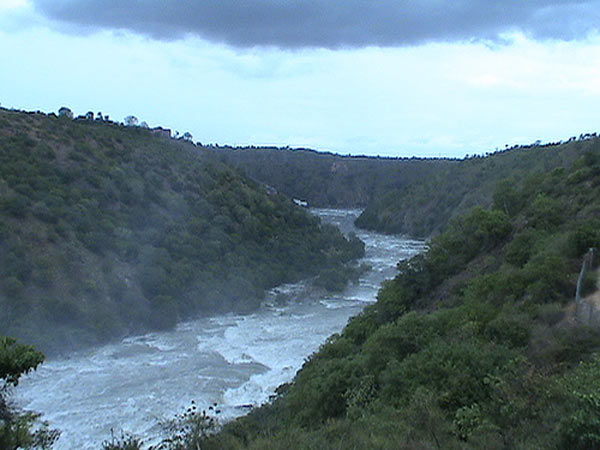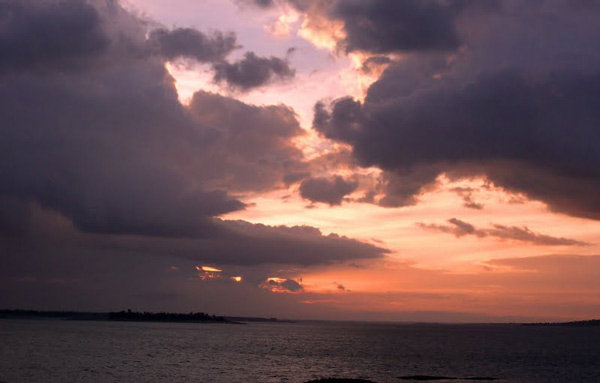Kaveri River
|
About:
|

The Kaveri River, also known as Cauvery, is one of the major rivers in
southern India, flowing through the states of Karnataka and Tamil Nadu
before reaching the Bay of Bengal. Known for its cultural, religious, and
economic significance, the river provides water for irrigation, drinking,
and hydropower. The Kaveri is revered as a sacred river and holds an
important place in Indian mythology and local folklore.
The origin of the River Kaveri is at the Talakaveri (Western Ghats) of
Karnataka. River Kaveri originates in the Brahmagiri hills in Kodagu. This
place is called Talakaveri or the head of Kaveri. The river starts its
journey from the small pond called as Kundike pond, the two tributaries
known as Kanake and Sujyoti joins it later in the course. All these three
rivers meets at the point called Bhagamandala. It lies at an altitude of
1350 meters and generally flows from the direction of south to the eastward
direction. The river has an approximate length of 760 km. It flows in the
state of Karnataka and Tamil Nadu and finally merges into Bay of Bengal. The
major tributaries of the river Kaveri include Shimsha river, Arkavathy
river, Honnuhole river, Hemavati river, Lakshmana Tirtha river Kabini river,
Bhavani river, Lokapavani river and the Amaravati river.
|
Location info:
|
| The Kaveri River originates in the Western Ghats at Talakaveri in Kodagu (Coorg)
district of Karnataka, winding its way through Karnataka and Tamil Nadu before
forming a delta and emptying into the Bay of Bengal. Major cities along its
course include Mysore, Srirangapatna, and Tiruchirappalli.
|
Climate/Weather:
|
| Summer: (March to May) – Hot and humid along the plains, with temperatures
ranging from 25°C to 40°C.
Monsoon: (June to September) – Receives moderate to heavy rainfall, especially
in the Western Ghats, which helps replenish the river’s water levels.
Winter: (November to February) – Cool and mild, with temperatures between 15°C
and 28°C, ideal for visiting.
|
History:
|
| The Kaveri River has been central to the cultural and religious history of
southern India. It is mentioned in ancient texts, epics, and local folklore.
Various kingdoms, including the Cholas, Cheras, and Hoysalas, revered the Kaveri
and developed extensive irrigation systems along its banks, contributing to
agricultural prosperity in the region. The river has also inspired numerous
poets, and its banks are home to many ancient temples and cultural sites.
|
Interesting things to do:
|
| River Rafting and Coracle Rides: Enjoy thrilling rafting and serene coracle
rides at various points, especially near Dubare and Hogenakkal.
Fishing and Boating: Certain stretches of the Kaveri, like Dubare, are known for
fishing and gentle boating experiences.
Trekking and Bird Watching: The Kaveri basin, especially near Coorg, offers
excellent trekking trails and bird-watching spots. |
Interesting things to Visit:
|
| Talakaveri Temple: Located at the origin of the river in Coorg, this is a
revered pilgrimage site for Hindus.
Shivanasamudra Falls: A stunning waterfall on the Kaveri River in Karnataka,
known for its scenic views and hydroelectric power station.
Ranganathaswamy Temple, Srirangapatna: A historic temple dedicated to Lord
Ranganatha, situated on an island in the Kaveri River.
Hogenakkal Falls: Known as the “Niagara of India,” Hogenakkal offers
breathtaking views and boat rides.
Mekedatu: A scenic gorge on the Kaveri, ideal for a day trip and sightseeing.
|
Mobile range info:
|
| Mobile connectivity is available in most areas along the Kaveri River, but
coverage may be patchy in remote sections, such as forested areas or near
waterfalls.
|
How to reach?
|
| Nearest Railway Station:Closest Railway Station: Mysore (146 km) |
| Nearest Airport:Closest Airport: Bangalore (260 km), Mangalore (135 km)
|
| Road Transport:The river is accessible from multiple cities in Karnataka
and Tamil Nadu, with a network of state highways and buses facilitating travel.
|
Nearest Visiting places:
|
| Coorg: Famous for coffee plantations, hills, and trekking.
Mysore: Known for its historical monuments, Mysore Palace, and Chamundi Hills.
Srirangapatna: A historic town with the Ranganathaswamy Temple and Tipu Sultan’s
Summer Palace.
Tiruchirappalli: Known for the Rockfort Temple and Sri Ranganathaswamy Temple at
Srirangam, the largest functioning Hindu temple complex in the world. |
Nearest Petrol Pump:
|
| Petrol pumps are available along highways and near major cities like Mysore,
Coorg, and Tiruchirappalli, providing easy access for travelers.
|
Hotels/Lodge/Accommodation:
|
| Coorg: Offers a variety of homestays, eco-resorts, and guesthouses near the
river’s source.
Mysore and Srirangapatna: Range of hotels, guesthouses, and heritage stays.
Hogenakkal: Limited accommodations, primarily guesthouses and small lodges, are
available for tourists.
|
Things to carry:
|
| Comfortable clothing and walking shoes.
Insect repellent, sunscreen, and a hat for sun protection.
Water bottle and snacks.
Camera for capturing the scenic views.
A small first-aid kit for emergencies. |
Tips & Suggestions:
|
| The best time to visit is during winter for a comfortable climate and clear
views.
Wear comfortable footwear, especially if trekking or visiting the falls.
Exercise caution near waterfalls and rocky areas.
Respect local customs at temples and pilgrimage sites.
Inform others of your plans, especially if venturing into remote areas with
limited mobile reception.
|
Help Line/Phone Number:
|
| Police Station:Police Control Room at Coorg : 100 or 08272-229333 |
| Nearest Hospital:Government Hospital at Coorg : 08272-223445 / 223444
|

































